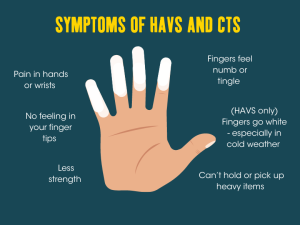Bad Vibrations
Jun 28, 2024

Tools, vehicles, and heavy equipment all create vibrations that can affect your body. This is a normal part of any tradie’s day, whether you’re picking up power tools or jumping in the ute. It’s so common that many don’t realise the potential harm these vibrations can cause. However, it’s something you should start thinking about and being aware of.
How are workers harmed?
Vibrations are a natural part of working on any construction site but they do create a risk to you and your workers. Repeatedly using vibrating hand and power tools, or being around vibrating vehicles and machines can lead to serious and lasting harm to your blood vessels, nerves, and joints. Many of the most commonly used items give off some form of vibration. Here are the most common ways tradies are exposed to vibrations:
- Power tools
- Vehicles and machinery
- From our working surfaces being exposed to vibrations (including break or smoko areas)
While these are the most common forms of exposure, the below should also be considered as they increase the risk of overexposure to vibrations:
- Working in cold and damp conditions
- Increased grip force
- Working with power tools for extended periods
Early warning signs
We understand that for many tradies, working with vibrations is a natural and unavoidable part of the job. With that in mind, there are a few warning signs and symptoms of overexposure to keep an eye out for:
- Tingling and numbness in your fingers (which can lead to disruptions to your sleep patterns – not ideal!)
- Loss of feeling in your fingers
- Loss of strength, both grip and holding, in your hands
- Fingers turning white and red when working in cold/ wet conditions
If you are continually exposed to vibrations especially in your hands and arms you can develop hand-arm vibration syndrome (HAVS) or carpal tunnel syndrome (CTS).

What you can do to manage risk
It is up to everyone on-site to look out for each other. Consultation with your team should take place to make sure an environment can be created where excessive exposure to vibrations are eliminated or minimised.
Below are simple yet effective ways to either eliminate or minimise the effects.
- Use suitable low vibration power tools where possible
- Use the right tool for the job – don’t use a power tool to get the job done faster when it is not required. Enjoy the task, don’t rush
- Look after your tools, vehicles and machinery – get them serviced regularly, repair any breaks or faults as soon as possible and store them properly – keep them out of the cold and rain
- Avoid gripping or being too forceful with a tool
- Keep your body moving and take a break if needed
- Wear the correct equipment and clothing
Above all else, be aware that vibrations can be extremely harmful, especially when you’re exposed for lengthy periods of time.
Your best tool for minimising the effects of vibrations is to start a conversation with your boss, or your team, and put steps in place to look out for each other and your equipment.
If you have any questions please reach out the the HazardCo team














